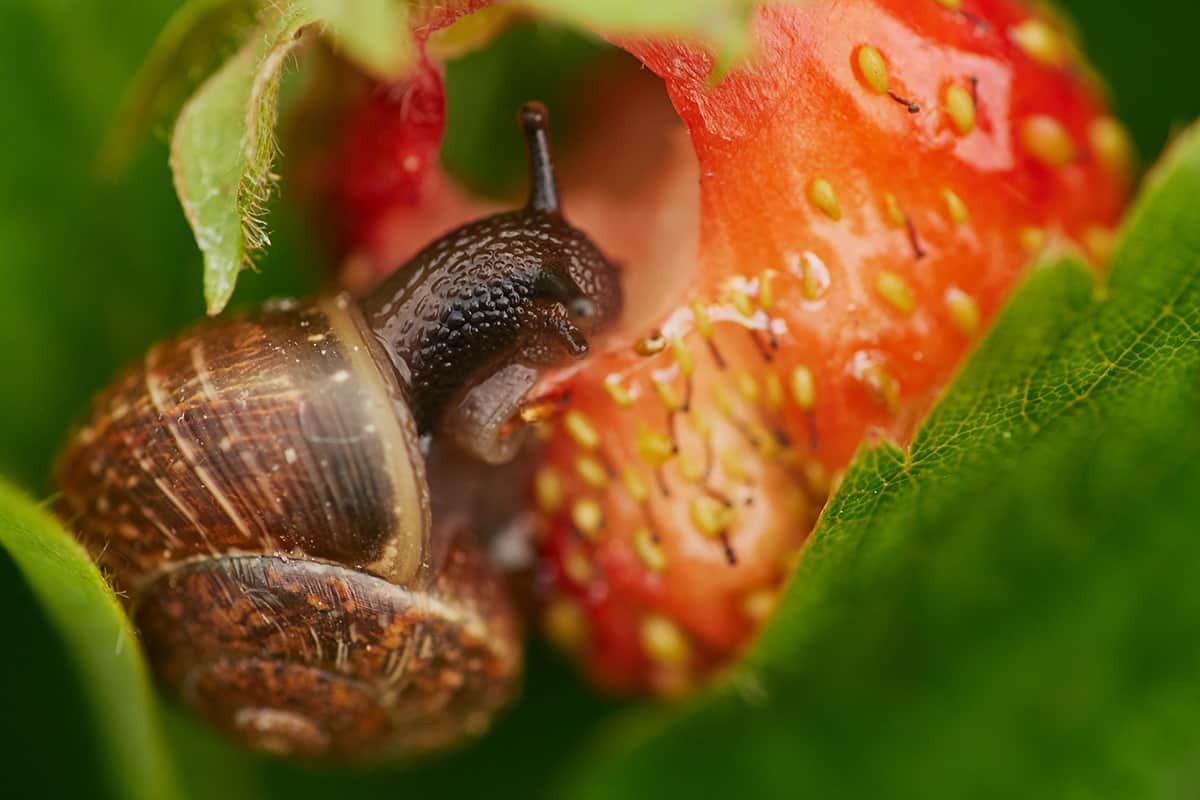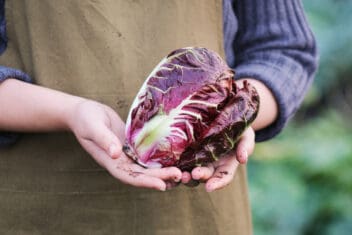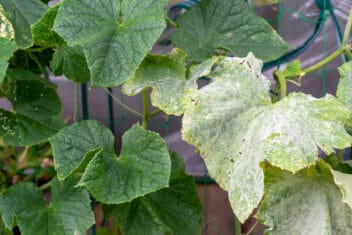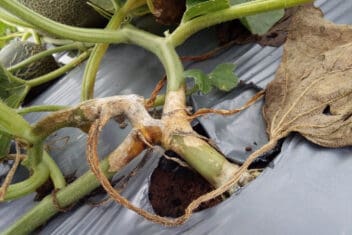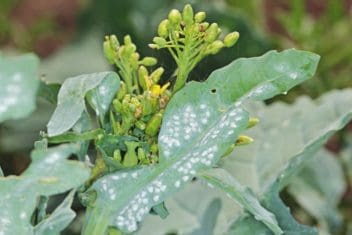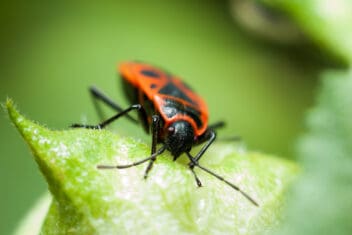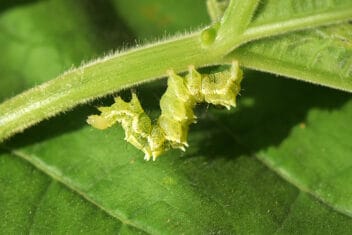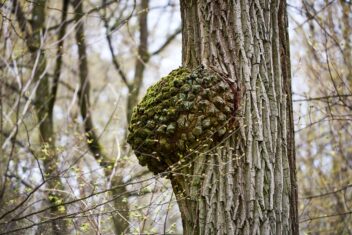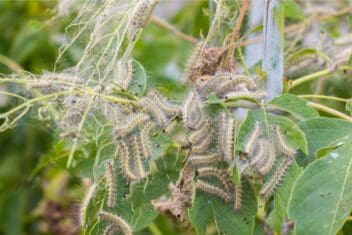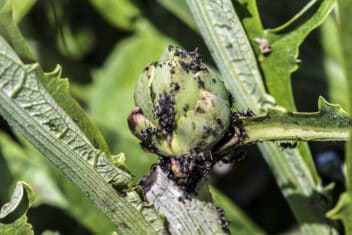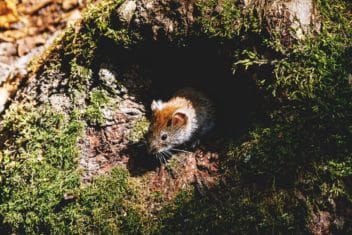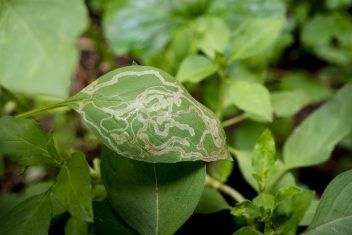Strawberry plants are one of the easiest fruit plants to add to your garden, but that doesn’t mean you won’t encounter common strawberry pests and diseases. Pests and diseases love strawberry plants as much as we do!
The first year I grew strawberries, I lost most of my harvest to a terrible aphids infestation. It turns out that dealing with strawberry pests and diseases was harder than I expected. I spent time learning about the common pests and diseases that infect strawberry plants and how to prevent them to the best of my abilities.
Here are some of the most prevalent strawberry pests and diseases.
14 Common Strawberry Pests
Strawberries are delicious! Everyone loves them, including insects. There are lots of pests out there just waiting to chomp on your strawberries. Here are the most common.
1. Aphids
Aphids are one of the most common garden pests, so it’s not surprising that they’re one of the common strawberry pests, as well. These are small, soft-bodied insects that like to stick to the underside of leaves and stems, sucking out the sap from the plants. Then, they leave behind a sticky substance called honeydew that attracts other pests and diseases.
Small infestations rarely cause serious problems, but severe infestations can destroy entire crops. Be sure to take a look at our guide to getting rid of aphids in your garden.
2. Armyworm
Armyworms are a destructive garden pest that causes closely grouped irregularly shaped holes on the leaves of the plants. If heavy feeding happens, you’ll end up with skeletonized leaves and dry wounds on the pests. Armyworms also leave egg clusters on the leaves; these pests produce 3-5 generations per year.
Organic control methods work for armyworms like releasing natural enemies or applying Bacillus thuringiensis. Take a look at our guide for armyworms in the garden.
3. Japanese Beetle
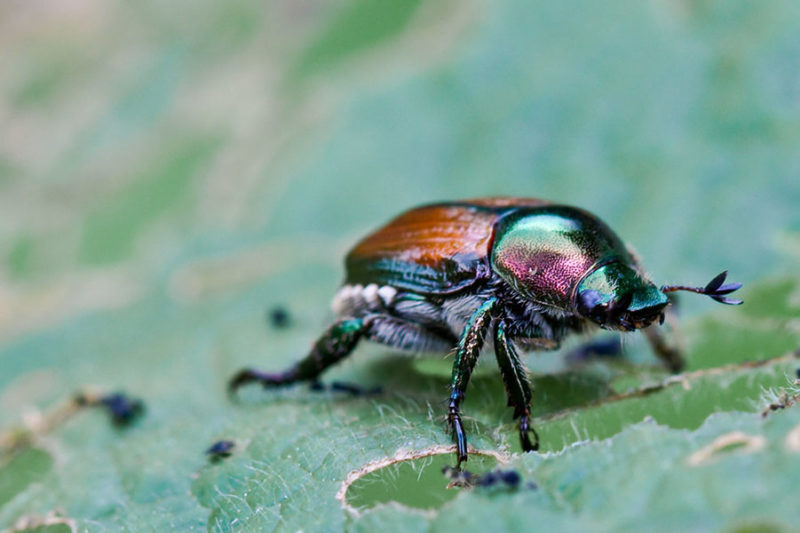
Japanese beetles are easy to spot; they have a green-copper metallic color and measure 13mm in length. Adult Japanese beetles skeletonize leaves and cause flower damage. If left alone, these pests will cause extensive plant damage.
Using floating row covers is a great way to protect your plants from these pests, and if you spot the adult beetles, you can hand pick them off the plants and stick them in soapy water. Releasing parasitic nematodes also reduces the number of Japanese beetles overwintering in the soil.
If you’re struggling with Japanese beetles, consider spraying your plants with neem oil or insecticidal soaps. These reduce beetle populations.
4. Loopers
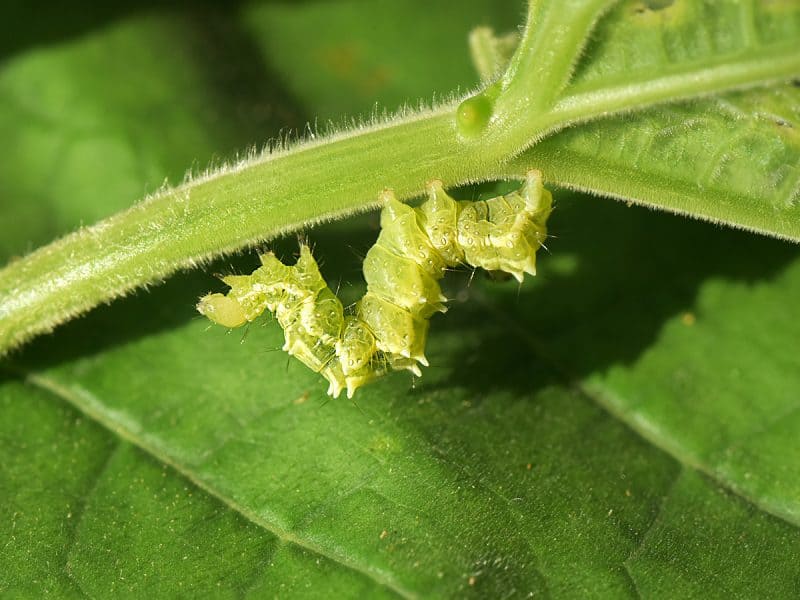
Another one of the most common strawberry pests is loopers. These pests leave behind large and/or small holes, causing extensive damage. Loopers are pale green caterpillars that have white or cream lines running down either side of their body. They usually stick to the lower leaves of the plants.
The best way to keep looper populations in check is by encouraging and releasing natural enemies in your garden. Gardeners may also hand-pick loopers from the plants.
If these methods aren’t working for you, consider applying Bacillus thuringiensis, which will kill the larvae. Avoid using chemical sprays because they also kill off the natural and beneficial insects in your garden.
5. Slugs
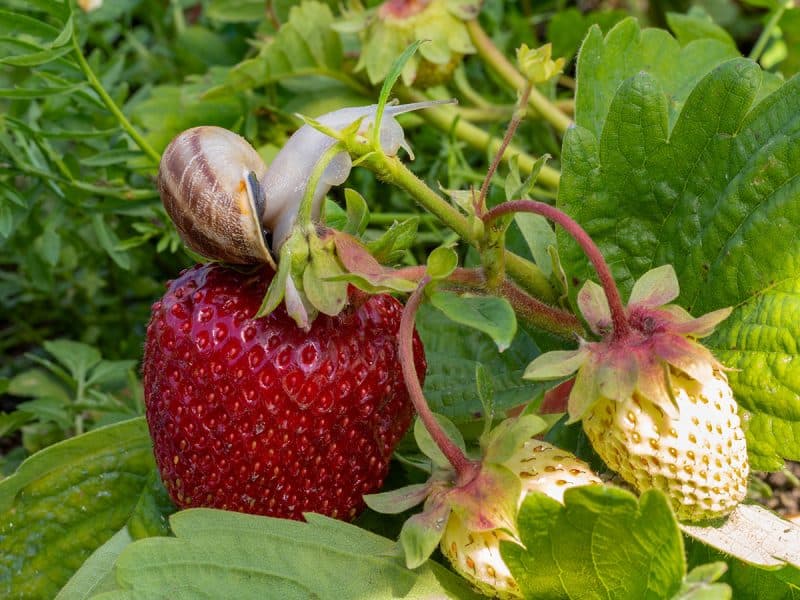
Everyone knows what slugs look like, but you might not know that these pests cause irregularly shaped holes in the leaves and stems of the plant. Slugs also eat holes in the ripening fruit, and during severe infestations, slugs might shred the leaves.
Removing garden trash, weeds, and debris help to reduce slugs because it takes away their hiding places. At night, handpick slugs off of your plants and spread eggshells around the plants to discourage these pests.
Take a look at all the ways you can get rid of slugs in your garden.
6. Strawberry Spider Mites
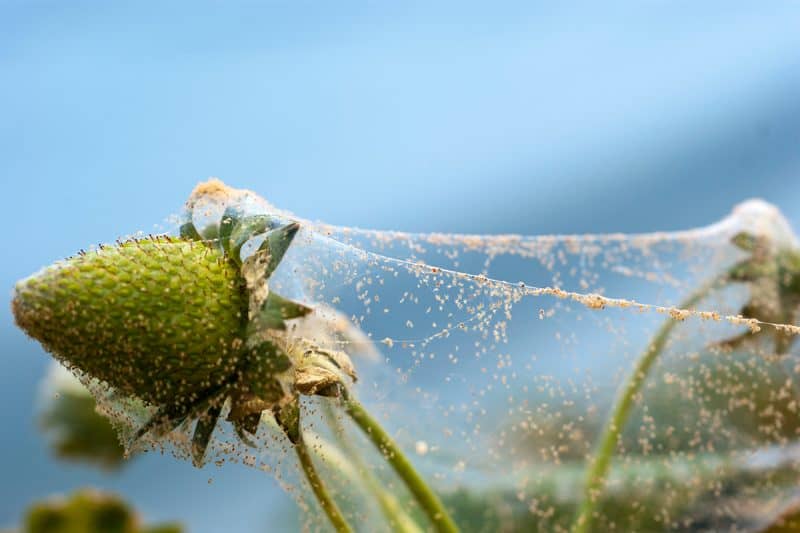
Strawberry spider mites and other species of spider mites are some of the most frustrating strawberry pests; they’re so small that they’re hard to control. A spider mite infestation causes yellow stippled leaves and bronzed leaves. They might also have webbing-covered leaves, and if you look closely, you might see mites moving on the webs or the underside of the leaves.
Spraying the plants with a strong jet of water is one way to reduce the spider mite population in your garden. Insecticidal soaps also can decrease population, along with different insecticides. Look to see if the insecticides you buy are useful against spider mites.
7. Thrips
Thrips cause damage to flowers on strawberry plants, causing the browning of anthers and stigmas. These insects are small; it’s easiest to see them if you have a magnifying glass. Adult thrips are pale yellow to light brown, and the nymph stages are smaller and lighter in color.
Thrips appear the most in the spring, appearing on weeds and crops like strawberries. Using reflective mulches is one of the best ways to deter thrips. You also can use appropriate insecticides if they become problematic.
8. Weevils
Weevils cause notches in the leaves of your plants, along with stunted growth and closely bunched leaves. This pest varies in color from dark to light brown, and the larvae are cream to white-colored grubs that feed on the roots.
Keeping your strawberry beds free of weeds is an important step to keeping weevils out of your garden. Don’t plant them too close to blackberries or elderberries which tend to have more weevils. Pesticides that contain pyrethroids are effective at controlling these populations.
9. Tarnished Plant Bugs
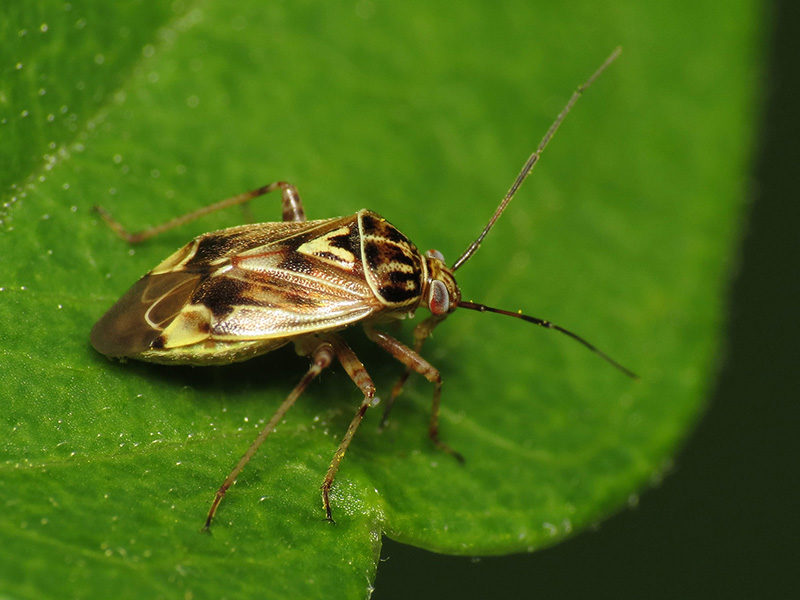
Tarnished plant bugs (Lygus lineolaris) are common strawberry pests, especially on young plants. The damage caused by these beetles and their young can be minimal if you treat the problem quickly. But, if tarnished plant bugs continue unchecked, they can ruin your harvest.
An adult tarnished plant bug is easy to spot. Its yellow, brown, and black body stands out against a strawberry plant’s red and green colors. These pests also have a small yellow “V” behind their head, another sign separating them from other pests.
Younger tarnished plant bugs are smaller and pale green. They often resemble aphids, which makes it difficult to identify them when they’re young. Even though their lifespan is only 30-40 days, they can cause severe damage during this time.
They use their sucking mouthparts to feed on the sap of the plant, spreading diseases as they feed.
These pests like to live in areas with weeds and other cover plants, so situate your strawberries away from bushes, shrubs, and trees, and stay on top of weeds. Plant strawberries near pollen-producing plants, which encourages natural predators.
If you still experience problems, spraying an insecticide that contains pyrethrin, like PyGanic Gardening, is an effective treatment option.
10. Sap Beetles

Strawberry sap beetles (Stelidota geminata) are small insects with oval-shaped bodies. They are usually dark with yellow or orange spots, and the adults are the most dangerous to strawberry plants.
Unlike other pests, sap beetles like to snack on damaged fruit, making them a particular problem for ripe fruit around harvesting. The first sign of sap beetle infestation is the appearance of small holes in the berry.
If the pests have been feeding on your plant for a long time, they can leave a massive hole in one side of the fruit.
Be extra cautious with sap beetles because they can migrate to other plants and destroy them, too.
Remove dead fruit or damaged leaves immediately and avoid damaging the fruit when pruning or working around your strawberry patch. Monitor plants after a heavy rainfall, as this is the perfect climate for sap beetles.
Use an insecticide containing pyrethrin if you’re having trouble managing these pests.
11. Spittlebugs
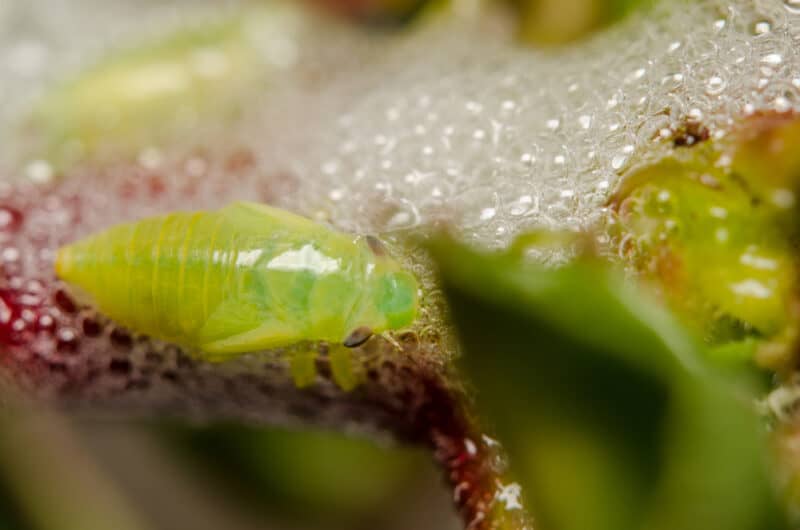
Spittlebugs or froghoppers can reduce the size of your berries and stop the fruit from growing. It’s easy to spot these pests as they leave a bubbly foam on the plant when you’re examining your plant for damage.
These pests are part of the Cercopoidea family. You need to remove these pests when the foam symptoms appear, as this is a sign that young insects are hiding from predators.
You don’t need to worry about your plant dying from spittlebugs, but they can severely stunt its growth. You might miss out on next year’s harvest if you don’t deal with spittlebugs.
If you catch these pests in the early stages, you can spray the plant with water to remove them. For more tips, head to our comprehensive guide.
12. Root Weevils
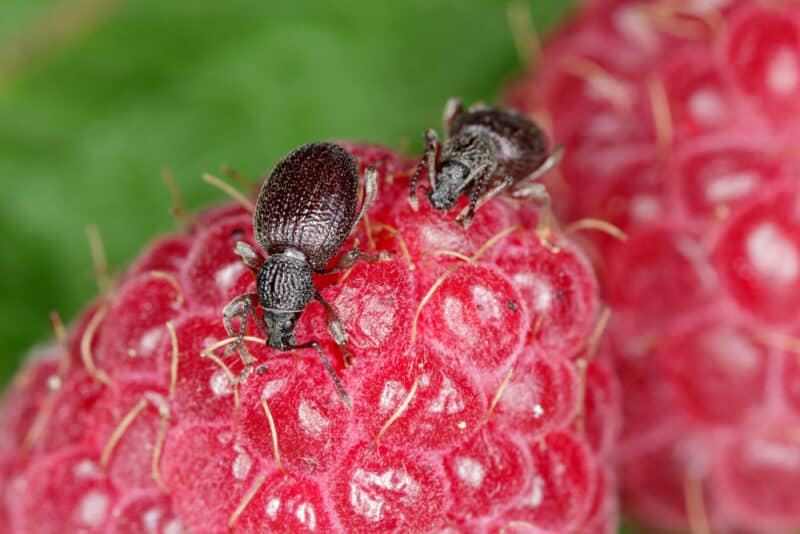
Strawberry root weevils (Otiorhynchus ovatus), rough strawberry weevils (O. rugosostriatus), and black vine weevils (O. sulcatus) feed on strawberry plants. They prefer the roots of young plants, but they’ll feed on older strawberries, too.
Since these strawberry pests typically burrow into the plant’s roots, it’s difficult to treat them unless you catch them in the early stages.
Adult root weevils are brown or black and are around 1/3 inch long. They feed on the leaves of the plants. Adult root weevils emerge from the plant in late May or summer but only feed at night. Some root weevils will only eat for 10-14 days. Other species will eat for 30-60 days before laying eggs.
Once the eggs are laid, that’s when the real problem begins. The eggs overwinter in the ground and then the larvae hatch in the spring. It’s the larvae that feed on the roots of the strawberries.
To kill the eggs and larvae, turn over the soil in the winter or early spring before planting. This will expose the eggs and larvae to hungry birds and other predators. Once your plants are in the ground, place cardboard next to them.
The adults will hide under the cardboard, and you can lift it up and look for the strawberry pests. If you see them, it’s time to act.
Use a product containing Bacillus thuringiensis, a beneficial bacteria, to kill the eggs, larvae, and adults. Beneficial nematodes, which you can purchase at Amazon, are also highly effective at controlling larvae and eggs.
13. Spotted Wing Drosophila
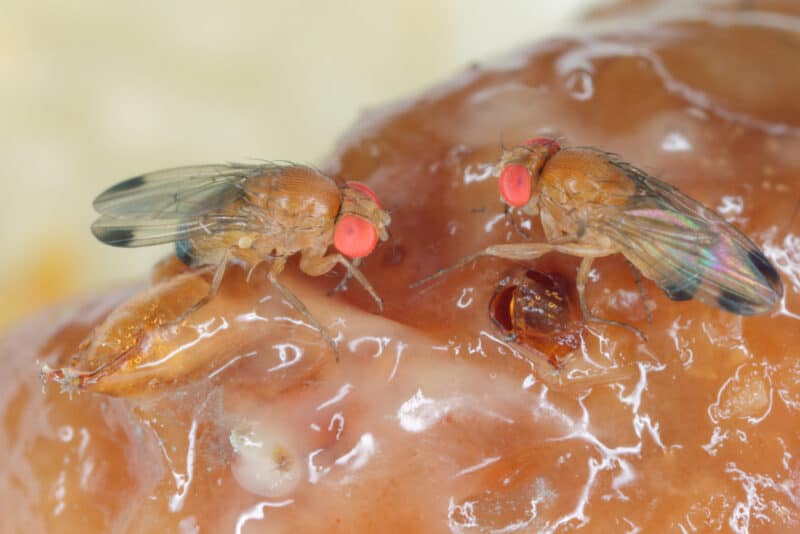
Spotted wing drosophila (Drosophila suzukii) are another common pest on strawberry plants.
The adult flies will leave their eggs in ripening strawberries, and the young flies will hatch later once fully mature. You may have seen videos on social media of people soaking their strawberries and little worms emerging from the berry. Those are spotting wing drosophila larvae.
Their lifespan reaches from 30-40 days, and they can lay hundreds of eggs in that timespane. It’s hard to tell when they’re around unless you set up a vinegar trap.
You may start to see sunken spots and rot when the larvae are present, but you might not know you have a problem until you harvest the berries and find them inside.
To be honest, you don’t really need to worry about the maggots. If you soak your berries for 10 minutes, the worms will crawl out and you can dine safely. But the worms won’t hurt you if you eat them. In fact, you probably have eaten them before without knowing.
If the idea of fly larvae makes you sick, use netting over plants to protect them from flies. That way, the adults can’t lay eggs in the first place. Otherwise, maybe these strawberry pests can just be ignored.
14. Herbivores
When we think of strawberry pests, we usually imagine bugs, right? Herbivores can be every bit as damaging.
Herbivores are a valuable part of nature. Who doesn’t love to go hiking and spot a squirrel? But wildlife can be troublesome for gardeners growing strawberries.
Lots of animals adore strawberries, such as:
- Rats
- Squirrels
- Moles
- Rabbits
- Mice
- Chipmunks
- Birds
- Deer
Most people prefer a fence to protect their fruit from rodents, as it protects your fruit and doesn’t harm the animals.
You can build a fence to keep out wildlife by placing fencing two inches into the ground and six feet tall. If you have chicken wire, you can also use this to protect your plants, but wood or metal will do.
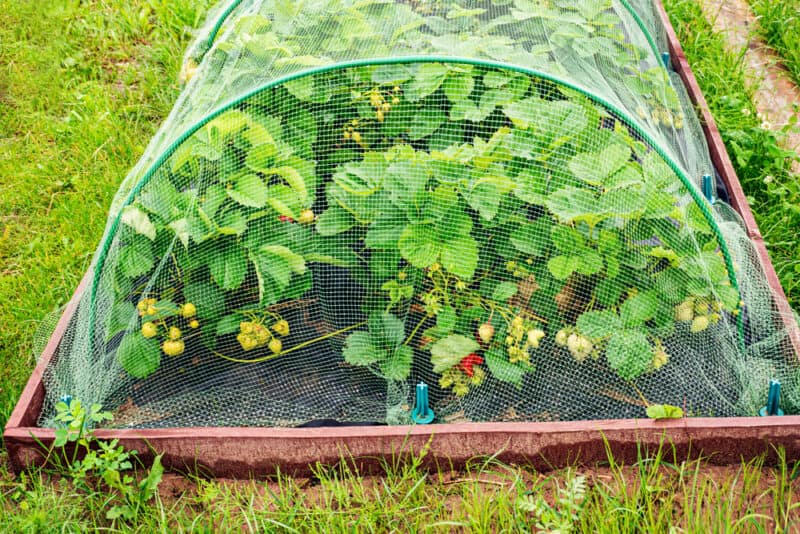
Netting will protect plants from birds.
The location of the plants also makes a difference. Keep your plants away from rodent habitats like woodlands. Keeping the grass short is also essential, preventing mice or rats from making a home in the garden.
Raised beds are great for growing strawberries because they provide protection from burrowing animals and keep the fruit separate from other plants.
5 Common Strawberry Diseases
These common diseases cause true problems for your plants, and severe infections can lead to the death of your strawberries, so make sure you learn about preventative measures to take in your garden. That means cleaning up your garden, as well as appropriate spacing, watering, and fertilizing.
1. Angular Leaf Spot
Angular leaf spot is a bacterial disease that causes small, water-soaked lesions to form on the lower surfaces of the leaves on your strawberry plants. Over time, the lesions enlarge and turn dark green, eventually oozing.
This bacterium survives in the debris of your crops and overwinters on the plants. It survives for long periods on the debris, but it won’t live in the soil. If you water your plants above, the bacteria spread through the splashing water on the leaves.
Unfortunately, getting rid of angular leaf spot is difficult, if not impossible. It’s smart only to plant certified disease-free stock and to rotate your crops. Using any form of chemical control will be totally ineffective against this bacterial disease.
2. Anthracnose
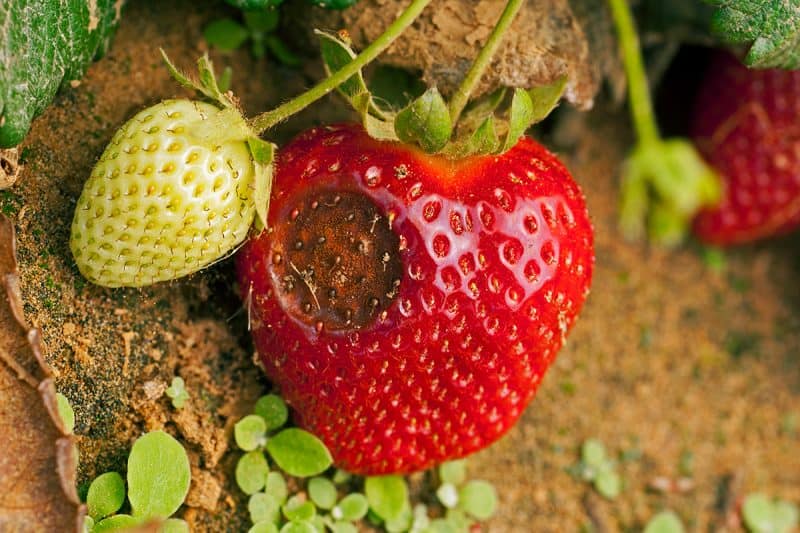
Anthracnose is a fungal disease that causes round black or light gray lesions on leaves, but the foliage may not die. It also causes dark brown or black, circular lesions on the stems. This disease causes a range of signs and symptoms; take a look at our anthracnose guide.
While anthracnose is one of the most common strawberry diseases, it’s also hard to control. Solarizing the soil is one of the best options, as well as weeding plants regularly.
3. Gray Mold
Gray mold is a common fungal disease that causes strawberry blossoms to turn brown and die. It also causes misshapen and rotting patches on the fruit. You’ll find masses of gray mycelium on the rotting tissue, and eventually, the fruit becomes dried and mummified.
Gray mold emerges after periods of high humidity and moisture. Controlling the weather is impossible, though you can control, the environment. Water at the soil level and keep plants well spaced.
You have to remove and destroy all dead or infected material and toss any decaying fruits. Applying fungicides is a good measure against it, but there is no guarantee they’ll work.
4. Leaf Scorch
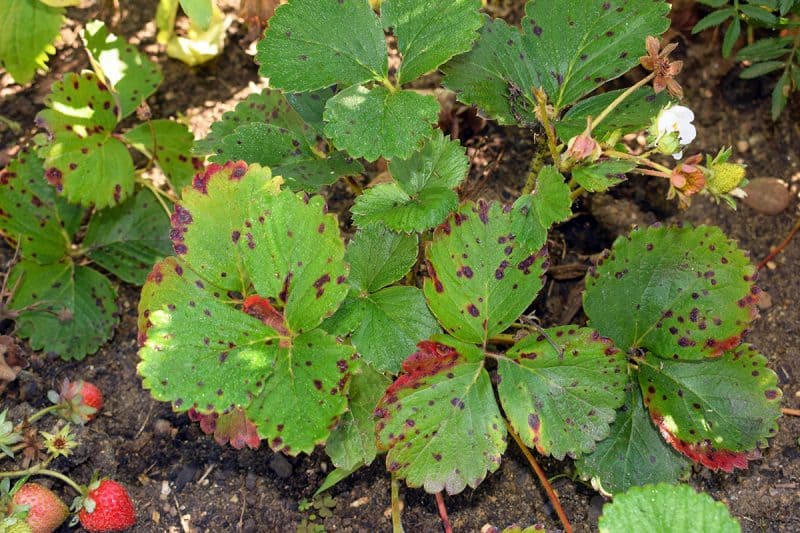
Here is a fungal disease that causes irregular dark purple or brown blotches on the upper leaf surfaces. Over time, leaf scorch causes larger purplish-brown patches, and the tissue between the blotches might turn purple or red.
Leaf scorch causes lesions on the flowers and fruits as well. It happens most often when the foliage stays wet for a long time. It might cause petals to wither and drop off the plant, and it causes the death of the fruits.
Ensuring your strawberry plants also have good air circulation and soil drainage is essential. Applying foliar fungicide may provide enough control in this situation.
5. Powdery Mildew
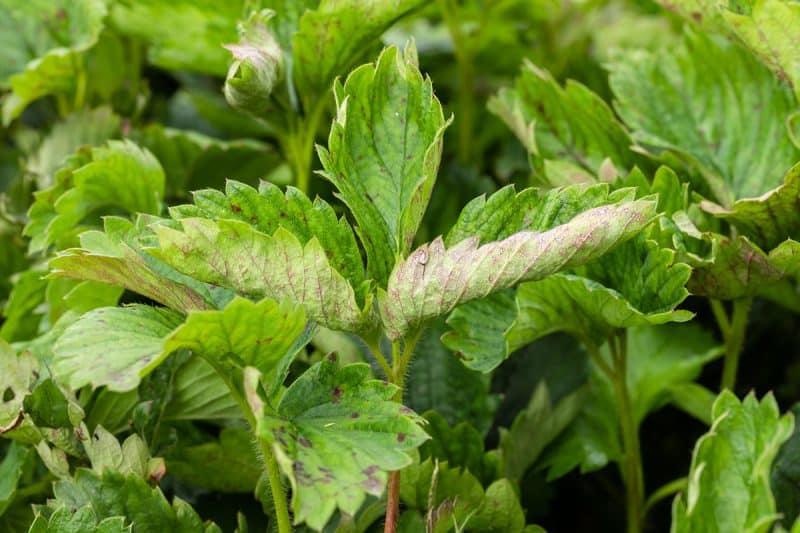
Powdery mildew is one of the most common fungal diseases that you’ll find throughout your garden. It causes patches of fuzzy white fungal growth on the lower leaf surfaces that eventually enlarge, and you might find purple-red blotches on the lower leaf surfaces.
If powdery mildew takes over your plants in a severe form, your plants might produce no fruits at all.
The spores overwinter on leaves and spread easily by the wind. You can try applying a protection fungicide at the first signs of the disease. It’s one of the most effective measures.
You can learn more about powdery mildew in the garden by reading our guide.
